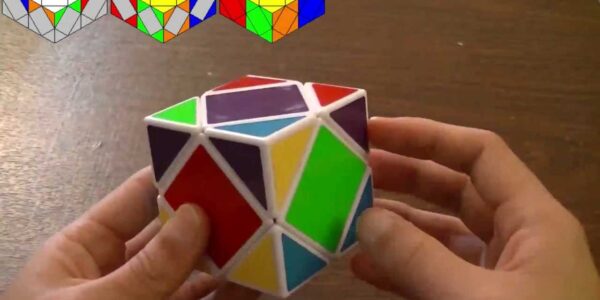How does a Skewb turn?
Rotating the whole Skewb
Rotate the Skewb by turning the top layer.
Rotate the Skewb by turning the bottom layer.
Turn an edge of your cube, then rotate it to a new position and repeat until you’ve done all four edges in order to complete this step of your puzzle!
What it looks like when you turn a Skewb
The Skewb cube is a 3D shape. It’s a shape with four colors and twelve edges, eight corners, and two faces.
When you turn it, the skew rotates around its center axis like this:
The Skewb can also be turned on its side so that the tips of each edge are pointing upwards:
A Skewbs more complicated than a cube
The Skewb is more complicated than a cube, but it may be easier to understand if you compare it to other shapes. The Skewb has only four colors: white, black, red, and blue. This is the same as a regular Rubik’s Cube except for one thing: each face of the cube has an integer number assigned to them (1-6). This means that there are only nine possible permutations in which these squares can be placed on their faces:
4 x 1 + 3 x 2 + 3 x 3 + 4 x 4 = 27 permutations;
2 x 1 + 2 x 2 = 6 permuations;
1 x 1 = 9 permutations;
Skewb has only four colors, but the patterns can still be complicated.
In order to understand how a Skewb turns, you need to know something about how it works. The skew consists of six pieces: two corners and four edges. Each piece has its own color scheme and pattern the colors are different for each piece. For example, one corner might have red on top and blue below it; another could be made up entirely of green pyramids with red stripes running down their sides, and another may have white squares in place of some of its outermost points so that they don’t interfere with any other part when they’re mirrored on either side at 90° angles from each other along their axes an angle.
In this article, we’ll look at how a Skewb turns and how you can average it using the inverse.
What is a Skewb?
The Skewb is a shape mod of the cube. It’s one of several new cubes being produced by Japanese manufacturer Toystate, which has been making puzzles since 2002. The Skewb was designed to be the best way for you to learn about shape-changing skews. It can be used as a puzzle or just as an exercise in thinking about cubical relationships. It has 12 sides (2x2x2), 4 corners (1x1x1), and no center layer!
What is a Skewb turn?
The Skewb turn is a type of move that involves twisting the corners of your cube. The Skewb turn can also be considered to be an action or motion because it transforms one shape into another.
Averaging a Skewb turn
The average Skewb turn has five turns. The first turn is a 90-degree rotation, followed by a 45-degree rotation and two more 45-degree rotations.
The average Skewb turn takes 0.66 seconds to complete, with each second taking 0.165 seconds to complete if you’re using a standard Skewb cube with 12 edges and 24 cuts per edge the maximum possible number of cuts. This means that the average Skewb turn will take about 23 milliseconds or around 1/100th of one second to complete!
What is the inverse of a Skewb turn?
If you have a Skewb, the inverse of your turn is called a Skewb in the opposite direction. This means that if you complete an outward-turning Skewb with 5 moves, then for your second move on the next turn you do an inward-turning Skewb with 4 moves. The inverse of this will be done by taking all four corners and placing them at their original positions (1st corner = 1st square; 2nd corner = 3rd square; 3rd corner = 4th square) then performing another outward turn so that they again make contact with each other at their original positions (1st corner = 1st square; 2nd corner = 3rd square; 3rd corner = 4th square).
Thinking about how to average a Skewb turn gives you an idea of what it means to be balanced. The average of a Skewb turn is a half twist. To find the average of a Skewb turn, you need to do two things:
measure how far your cube has turned since it was first solved, and then add up all those measurements and make sure your calculator doesn’t overcount.
Conclusion
I hope this post has given you a better understanding of how a Skewb cube turn is done. I also hope that you now know what the inverse, or average, of your Skewb turn is! A very similar cube is the infinity cube. Do check about it in our next blog.


 For all latest news, follow The carefulu Google News channel.
For all latest news, follow The carefulu Google News channel.





